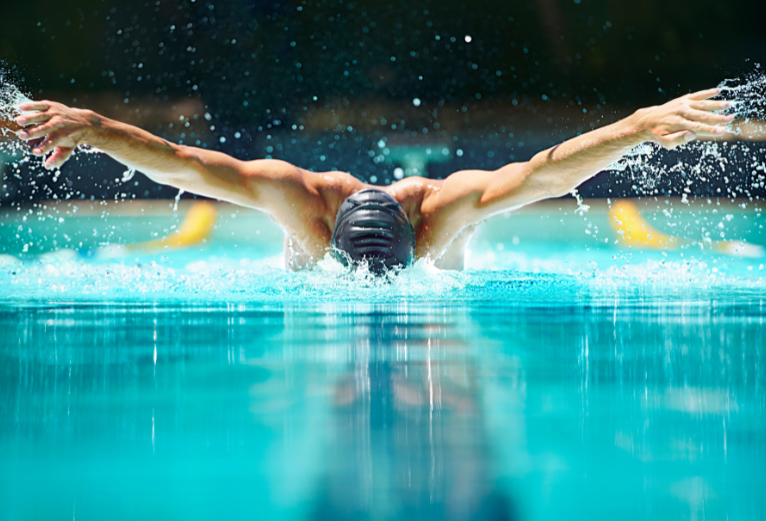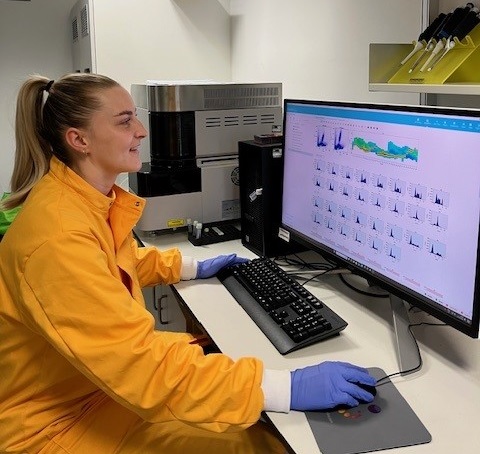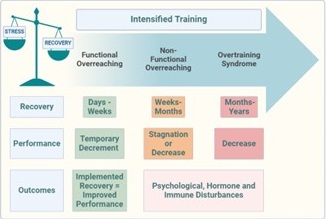Overtraining is a serious condition that can leave athletes in recovery for years, but what if there was a tool that could flag when an athlete was at risk of overtraining to prevent injury and boost performance?

Carla Baker
Sport Health and Performance Enhancement (SHAPE) Research centre, Nottingham Trent University, UK
“30-60% of athletes will experience the negative effects of overtraining during their career from both individual and team sports,” states Carla Baker, an exercise physiologist at Nottingham Trent University, UK. A tool that could flag when an athlete is entering this state could be a game changer for the individual and their team, preventing months or even years spent in recovery. An early diagnosis would limit the risk of the condition becoming chronic, slimming the athlete’s chance of returning to peak sporting performance.
To learn more about such a tool and how it could work, we interviewed Carla to tell us about an exercise stress test, published in Experimental Physiology. A study that showed how disturbances in the immune system could indicate when an athlete may be edging towards the negative states of overtraining.

Overtraining syndrome
Overtraining syndrome, characterised by performance declines, prolonged fatigue, and an inability to train or compete, is most common for endurance athletes, including swimmers, cyclists and runners, because of the high training volumes required to meet peak performance in these sports. “Despite the high prevalence of overtraining in athletes, there are currently no clear biomarkers of the syndrome, and it is often diagnosed retrospectively,” Carla says. “The overtraining syndrome can take months or years to fully recovery from, so it is vital we find a tool capable of highlighting when an athlete is entering the negative states of overtraining for early intervention. As of equal importance, developing a tool to aid investigations into changes in immune function induced by blocks of intensified training is crucial, given the frequency of training camps athletes attend.”
A lifelong fascination with sporting performance and how the human body can adapt to physical and mental stress, drove Carla to understand the physiological factors that may prevent athletes from performing at their very best. So, she set forth on this endeavour, leading to researching immune function and tracking exercise induced fluctuations. More precisely, examining the dysfunction that can occur when athletes push their physiological boundaries.
Immune disturbance and poor performance
“Ultimately, if an athlete trains too much and rests too little i.e. overtrain, they will likely experience a decline in their performance. Of course, this is detrimental for an athlete needing to compete at the top of their game,” explains Carla. “If this training/recovery imbalance continues over prolonged periods, the performance decline can take months to years to fully recover from, and some athletes may never fully recover.” She adds that athletes may also experience other problems during periods of overtraining, including increased fatigue, poor sleep quality, low mood, and immune and hormonal disturbances.
An exercise stress test
“The main issue we have is there are currently no clear biomarkers of the overtraining syndrome and it’s often detected too late,” states Carla. “Researchers have previously identified that athletes who are overtrained have a lowered hormone response to an exercise stress test, a test that measures how the body functions and reacts to exercise. For example, in a healthy state, a short exercise stress test elevates hormone (i.e. cortisol and testosterone) levels, while the hormonal elevation is blunted after a really intense period of training.”
The known link between hormones, like cortisol and testosterone, and the immune system, inspired Carla’s interest in exploring the differing response of the immune system to exercise stress. Together with researchers from the Sport Health and Performance Enhancement (SHAPE) Research centre and the Medical Technologies Innovation Facility (MTIF) at Nottingham Trent University, UK, Carla developed and administered an exercise stress test to evaluate its usefulness in highlighting immune alterations that may occur with intensified training.
“Our first step was to develop an exercise stress test that could induce repeatable and robust elevations in immune cell counts when healthy. This could highlight any immune alterations that may occur with the intensified training periods athletes often endure.”

Tracking changes in the immune system
“We developed a 30-minute cycling stress test, based on a previously used model showing hormonal changes with overtraining,” says Carla. “The participants cycled for blocks of one-minute ‘easy’ followed by four-minutes ‘hard’, which was repeated across the 30 minutes.”
12 male participants completed this stress test on two occasions, two to seven days apart. Blood samples were taken at specific time points before and after the cycle. “We collected blood before, immediately after each stress test and again at 30-minutes post exercise,” says Carla. “We used these samples to analyse changes in immune cell counts via flow cytometry, because we were curious whether these changes would be the same on both occasions.”
Exercise elevates immune cell counts
“Our stress test elevated the immune cells in the blood immediately post exercise which returned to baseline 30-minutes post exercise. These changes in immune cell count were shown to be the same on both occasions. Carla explains, “this means we can be confident that if utilised before and after a period of intensified training any differences in immune count changes after the training period are likely to be due to the training stress, rather than variability with the stress test.”
Maintaining balance
The influence of cortisol and testosterone on the immune system, makes them potential biomarkers, as the exercise induced hormonal levels in the body may indicate a healthy vs an overtrained athlete. “Both cortisol and testosterone exert anti-inflammatory effects on the immune system,” Carla adds, “Although they are commonly described as immunosuppressive in the literature, they regulate the correct strength of immune response and may protect against auto-immune issues.”
Both hormones regulate the balance of pro-inflammatory and anti-inflammatory mediators by modulating the expression of key receptors on dendritic cells (specialised immune cells that take up invading pathogens, and present them to immune cells with high effector functions in order to initiate a specific immune response).
Cortisol is responsible for redistributing highly cytotoxic immune cells out of the blood, and into the tissues after exercise. “In the tissues, these cytotoxic immune cells scan the body for any challenges that could compromise the immune system, a process called immunosurveillance,” Carla says. “Studies have shown that precursor molecules to testosterone improve the immune response against tumour cells and viral infections, whilst testosterone itself promotes immunity against parasites.”

Image Caption: Functional overreaching is often used by athletes during training camps. Although it leads to a short term decrement in performance, after sufficient recovery, overall performance should improve. If there is no recovery period, the training stress continues which leads to non-functional overreaching. This decreases performance and can take weeks to months to recover from. If the stress/recovery imbalance further continues, athletes will experience the overtraining syndrome. (The image has been adapted from ECSM and ACSM ‘Prevention, Diagnosis, and Treatment of the Overtraining Syndrome: Joint Consensus Statement’. DOI: 10.1249/MSS.0b013e318279a10a
Immune cells and hormone levels
Although a similar stress test previously induced elevated cortisol and testosterone levels, Carla and the team did not carry out a hormone analysis in this study and cannot confirm the hormonal response to exercise.
Carla cautions that the study only included males. “We know that immune cells and hormones fluctuate across the menstrual cycle, so we can’t be certain that females will respond in the same way to this stress test as males, or how the response could differ at various points of the menstrual cycle.”
She also highlights that only cell count measures were assessed, and stresses that an increase in cell count does not mean an increase in cell function. A relationship that Carla and her team are currently exploring.
Intensified training
“We are working on a study that uses this stress test before and after a period of intensified training to assess whether immune cell counts and their functions are altered following the training.
“Specifically, we are focusing on dendritic cells and their ability to mount an immune response to viral immune challenge,” Carla says. “Despite their extreme importance in the immune system, very little is known about how they respond to intensified training.”
Carla’s goal is to test this approach in athletes. Investigating the immune systems of overtrained individuals could help develop a diagnostic tool to keep athletes performing at the top of their game.
Read the full paper on the exercise stress test to learn more about the findings, published in Experimental Physiology.
References
Prevention, Diagnosis, and Treatment of the Overtraining Syndrome: Joint Consensus Statement of the European College of Sport Science and the American College of Sports Medicine. Medicine & Science in Sports & Exercise 45(1):p 186-205, January 2013. | DOI: 10.1249/MSS.0b013e318279a10a
Hough, J., Corney, R., Kouris, A., & Gleeson, M. (2013). Salivary cortisol and testosterone responses to high-intensity cycling before and after an 11-day intensified training period. Journal of Sports Sciences, 31(14), 1614–1623. https://doi.org/10.1080/02640414.2013.792952
Hough, John P; Papacosta, Elena; Wraith, Elizabeth; Gleeson, Michael. Plasma and Salivary Steroid Hormone Responses of Men to High-Intensity Cycling and Resistance Exercise. Journal of Strength and Conditioning Research 25(1):p 23-31, January 2011. | DOI: 10.1519/JSC.0b013e3181fef8e7

